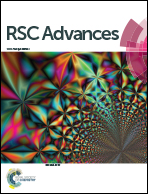Catalytic activity of reusable nickel oxide nanoparticles in the synthesis of spirooxindoles
Abstract
This study focuses on nickel oxide nanoparticles as efficient nanocatalysts in the synthesis of oxindoles as an important class of potentially bioactive compounds. The oxindole derivatives were prepared by the condensation of malononitrile, 1,3-dicarbonyl/4-hydroxycoumarine and isatin compounds in water, an excellent solvent in terms of environmental impact and reduction waste production.


 Please wait while we load your content...
Please wait while we load your content...